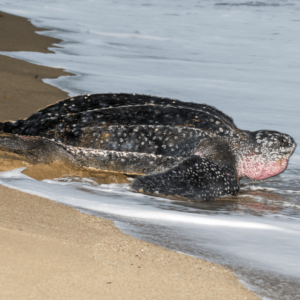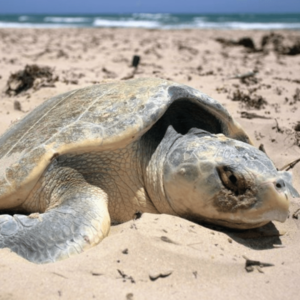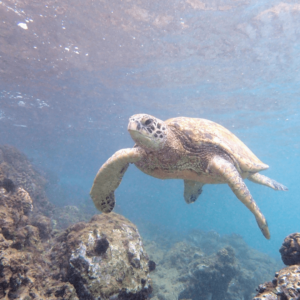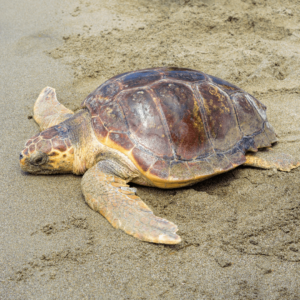-
Adopt
-
Veterinary Care
Services
Client Information
- What to Expect – Angell Boston
- Client Rights and Responsibilities
- Payments / Financial Assistance
- Pharmacy
- Client Policies
- Our Doctors
- Grief Support / Counseling
- Directions and Parking
- Helpful “How-to” Pet Care
Online Payments
Referrals
- Referral Forms/Contact
- Direct Connect
- Referring Veterinarian Portal
- Clinical Articles
- Partners in Care Newsletter
CE, Internships & Alumni Info
CE Seminar Schedule
Emergency: Boston
Emergency: Waltham
Poison Control Hotline
-
Programs & Resources
- Careers
-
Donate Now
Sea Turtles Along Massachusetts Shores
Four of the seven species of the world’s sea turtles visit Massachusetts waters: the Kemp’s Ridley turtle, the green turtle, the loggerhead turtle, and the leatherback turtle. They migrate north to forage when our coastal waters warm. Sea turtles are reptiles and so are ectothermic meaning their body temperatures are determined by the water temperature. They’re seen along our coast when they surface to breathe, though they can hold their breath for as long as seven or eight hours. Adult sea turtles range from 100 pounds to more than 1,000 pounds and average three and a half feet in length.
- Leatherback
- Kemp’s Ridley
- Green
- Loggerhead
Kemp’s Ridley turtles are the smallest sea turtles weighing 100 plus pounds and measuring up to 30 inches. They live to be 30 years old or perhaps longer. The females mature sexually at 10 to 12 years old. They travel long distances to nest, usually to the tropical beach where they hatched. They nest every one to three years in May and July, laying up to three clutches of 100 eggs that incubate for 50 to 60 days. The females don’t attend to the nests. As with all sea turtles the survival of hatchlings depends on avoiding predators on the beach—birds, raccoons, humans, etc.—and in the water. Kemp’s Ridley hatchlings mature in the open ocean for as many as 10 years before returning to coastal waters. Green sea turtles can weigh up to 300 pounds or more, and reach four feet in length. They live possibly as long as 70 years. Females lay 100 or more eggs on tropical beaches about every two weeks in a nesting season. Adult loggerheads weigh in at as much as 350 pounds, and can be up to three and a half feet in length. Their lifespan is 70 or possibly 80 years. Loggerheads are slow growing, and do not reach sexual maturity until they are 35 years old. They nest throughout the world. In the U.S. these turtles nest mostly along the Gulf coasts of Alabama and Florida and the Atlantic coast of Florida, Georgia, South Carolina, and North Carolina. It’s estimated that there are more than 100,000 nests per year in the United States. Hatchlings and juveniles spend as many as 15 years developing in the open ocean. Leatherback adults range from five to six feet long and weigh 750 to 1,000 pounds or more. Their front flippers are long and back ones are paddle shaped for long distance travel. They grow fast and live up to 50 years. Leatherbacks nest every 2 to 4 years–some in winter–some in summer, laying approximately 100 eggs several times, and always at night. After two months of incubation, the hatchlings emerge from the eggs and scramble to the safety of the water.
These four species are omnivores and forage in Massachusetts waters. They feast on everything from seaweed and algae (green turtles), to crustaceans and jellyfish. Loggerheads, Kemp’s Ridley, and leatherback turtles use their powerful jaw muscles to eat hard-shelled bottom dwellers such as conchs, whelks, other mollusks, and horseshoe and other crab.
Threats to Sea Turtles
All of the sea turtle species found in Massachusetts are threatened under the Massachusetts and U.S. Endangered Species Acts (ESA). Kemp’s Ridleys are on the Red List of Threatened Species of the International Union for Conservation of Nature, and are considered the most endangered sea turtles in the world. As with most sea life, all sea turtles face multiple threats from human-caused problems, the most deadly being fishing-gear entanglement. Threats also include vessel strikes, human consumption of turtles and eggs, loss of nesting habitat, ocean pollution/marine debris, and even ingestion of plastic trash that the turtles mistake for food. Leatherbacks sometimes ingest balloons and plastic shopping bags because of the resemblance to their jellyfish prey.
Strandings due to climate change deplete the Kemp’s Ridley population. This is because global warming has increased ocean temperatures thus expanding their range north. As winter moves in cold ocean water stuns them, leading to hypothermia. Most of the Kemp’s Ridleys stranded in Massachusetts are juveniles that wash ashore in late fall through early winter on the bayside of Cape Cod, generally from Barnstable to Provincetown.
How is Massachusetts Helping?
In 2020 the Massachusetts Division of Marine Fisheries (DMF) and the Provincetown-based Center for Coastal Studies received $200,000 to continue the Massachusetts Large Whale and Sea Turtle Conservation Program. The program monitors these sea creatures and their habitats in Massachusetts waters through surface and aerial surveillance of Cape Cod Bay. Also, staff perform at-sea rescues of endangered sea species, remove marine trash, and develop ship strike avoidance techniques and advances in fishing gear. Additionally, in 2020, almost $600,000 in grants were awarded to 16 projects across Massachusetts to restore and improve aquatic habitat — rivers, watersheds, and estuaries — and to protect endangered marine animals. To help with trash on beaches, each September the Massachusetts Office of Coastal Management (CZM) holds its COASTSWEEP event to clean beaches and generally raise awareness of the environmental cost of ocean trash. COASTSWEEP is part of the Ocean Conservancy’s annual International Coastal Cleanup.
Entanglement in fishing gear is another danger for these turtles, but thankfully, since the 1990s, the numbers of entangled turtles have dropped because of the mandated use of Turtle Excluder Devices in trawl nets. Entanglements can be reported on the Marine Animal Entanglement Hotline (800-900-3622). Boaters can report on VHF channel 16 and wait for responders to arrive. Additionally, because leatherbacks become entangled in vertical lines from fixed fishing gear, the DMF partners with the Center for Coastal Studies to disentangle these turtles. This program responds to 10 to 20 entangled leatherback turtles annually.
The New England Aquarium responds to calls about distressed sea turtles. Each fall, staff and volunteer walkers from the Massachusetts Audubon Wellfleet Bay Wildlife Sanctuary comb dozens of miles of beach trying to find stranded sea turtles. The turtles are transported to the rescuers and veterinarians at the New England Aquarium with extreme hypothermia, severe dehydration, pneumonia, and often shell or bone fractures. While 2014 was a record-smashing year when 692 turtles were treated at the Animal Care Center in Quincy, on average we treat about 300 turtles each year. During the 2022 stranding season, more than 500 turtles arrived at the facility. Their treatment can last between 2 and 8 months, sometimes longer. Most of the sea turtles that arrive alive at the Aquarium recover and are released back into the ocean. Strandings can be called into the NOAA Northeast Marine Mammal and Sea Turtle Stranding and Entanglement Hotline (866-755-6622).
Fun Facts
- Nearly all of the Kemp’s Ridley species nests on only three beaches in Mexico. (Fortunately these beaches have been protected so Kemp’s Ridleys numbers have increased somewhat in recent years.)
- Although most sea turtles lay their eggs at night, Kemp’s Ridleys lay their eggs during the daytime.
- Uniquely, Kemp’s Ridley turtles nest in large groups, which may provide protection from predators. The females gather offshore and then head to the beach as a group, dig holes and lay their eggs in the sand, and are back in the water within 30 minutes.
- Kemp’s Ridleys hatchlings break out of their shells using what’s called a caruncle, a single temporary tooth grown just for this purpose.
- Green turtles’ exteriors are not green; their fat is green because of their plant diet.
- Green turtles (and all sea turtles) are master navigators. How they find their way is still being studied. To navigate long distances they may use geomagnetic cues while using chemical cues such as odors in the water to find their way short distances.
- Loggerhead turtles are great navigators and long distance travelers: Hatchlings from beaches in Japan and Australia migrate nearly 8,000 miles across the Pacific to feed off the coasts of Mexico, Peru, and Chile.
- Leatherbacks are the largest of all the sea turtles.
- Leatherbacks are the only sea turtles without scales and a hard shell, and instead have a rubbery skin of bony plates connected by tissue.
- Some leatherbacks swim more than 10,000 miles a year between nesting and feeding grounds.
- Leatherbacks are deep divers, and can dive nearly 4,000 feet—deeper than most marine mammals—and stay submerged for 85 minutes.
- Leatherbacks can sleep underwater for six to eight hours; they hibernate for two months underwater.








